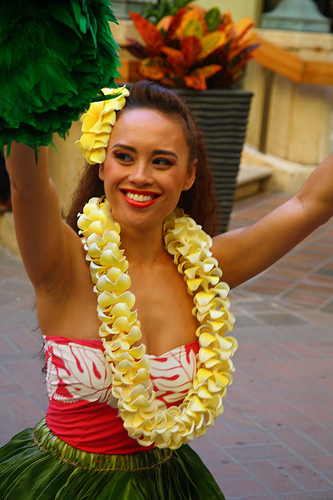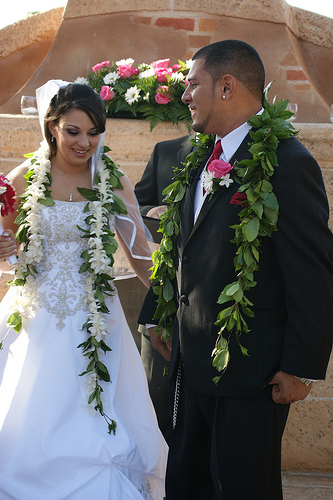A lei, one of the most well-known symbols of Hawaii, is a beautiful hand-woven wreath or necklace. It is most often made of tropical flowers, although shells or other materials may also be used. The most popular flowers for leis are orchids and plumeria; both are large and fragrant blossoms.
The giving of leis, and ancient Hawaiian custom, was observed by Captain Cook in 1779. The tradition is believed to date several centuries earlier than even this sighting. The original purpose of the lei was to distinguish between the varying social ranks. The wearer’s rank was reflected in the type of flower and construction method used in the lei. Today, leis are still worn by Hawaii’s most important figures, especially on holidays or for important public appearances.
Leis are also customarily worn or given on important occasions, ranging from births and deaths to victories, graduations, and religious ceremonies. Though not part of the ancient Hawaiian culture, today the giving of the lei is ordinarily accompanied by a kiss on the cheek, especially if the giver knows the recipient well. Depending on the symbolism of the occasion, different colors or varieties of flowers might be incorporated into the floral wreath. In ancient times, a lei ritual completed as part of a religious ceremony would be used to ask the gods for fertile crops or safety when traveling or fishing.
Leis are an appropriate Hawaiian gift not only for important occasions, but also as a symbol of appreciation, respect, love, or welcoming. Although lei giving was traditionally reserved for special occasions, today a lei has many different meanings, and can be seen at nearly every public gathering on the islands. In fact, many visitors receive a lei upon their arrival to the islands. The lei is given as a symbol of the “spirit of aloha,” which means a greeting, farewell, joy, hope, love, or other positive feelings. Leis made of beautiful flowers are meant as a non-verbal expression of aloha spirit.
In Hawaii, leis are almost always seen at weddings. There are several different ways to incorporate leis into the ceremony. The couple may have the wedding officiant bless or hold the flowers, which are then exchanged as a symbol of their love and commitment to each other. The leis may also be given by the couple to family members, a move that symbolizes the joining together of the families. The wedding party may wear leis instead of corsages and boutonnieres, or they may be given to guests as wedding favors, symbolizing the couple’s appreciation for guests’ support.
Today, leis are given on dozens of different occasions and symbolize many different feelings. Though there are almost no restrictions on lei giving, you do have a few responsibilities if you are the recipient of a lei. All leis are hand-woven, representing a gift of love. This gift should be treasured, especially if it is made from a particularly rare flower, which is considered a high honor. The lei should never be refused, and it should be worn around the neck, wrapped around your head, or on a hat brim. Do not wear it around your neck if you are pregnant; superstitious beliefs say that this symbolizes the umbilical cord tangling. Once the flowers have wilted, return it to nature, either to the place where the flowers were gathered, or letting it get carried away by a body of water. Never throw a flower lei in the trash.


